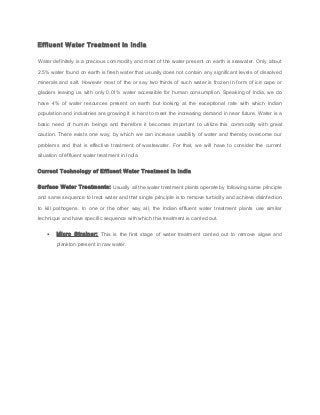
Effluent Water Treatment in India
- 1. Effluent Water Treatment in India Water definitely is a precious commodity and most of the water present on earth is seawater. Only about 2.5% water found on earth is fresh water that usually does not contain any significant levels of dissolved minerals and salt. However most of the or say two thirds of such water is frozen in form of ice cape or glaciers leaving us with only 0.01% water accessible for human consumption. Speaking of India, we do have 4% of water resources present on earth but looking at the exceptional rate with which Indian population and industries are growing it is hard to meet the increasing demand in near future. Water is a basic need of human beings and therefore it becomes important to utilize this commodity with great caution. There exists one way, by which we can increase usability of water and thereby overcome our problems and that is effective treatment of wastewater. For that, we will have to consider the current situation of effluent water treatment in India. Current Technology of Effluent Water Treatment in India Surface Water Treatments: Usually all the water treatment plants operate by following same principle and same sequence to treat water and that single principle is to remove turbidity and achieve disinfection to kill pathogens. In one or the other way all, the Indian effluent water treatment plants use similar technique and have specific sequence with which this treatment is carried out. • Micro Strainer: This is the first stage of water treatment carried out to remove algae and plankton present in raw water.
- 2. • Aeration: Usually different water treatment plants use different aeration methods such as gravity aerator, spray aerator, diffuser as well as mechanical aerator. It does not matter what aeration method is used but they all have one and basic principle and that is to strip and oxidize taste and odor causing volatile organics, gases and for oxidizing iron and manganese. • Mixing: Often described as flash mixing, rapid mixing and initial mixing under which chemical additive is blended or dispersed in the unblended water stream. Mixing is carried out where rapid dissolution of additive is necessary say about within 1 to 10 seconds. This is done for rapid but precise distribution of chemicals and gases in to the water that has to be treated. • Pre-Oxidation: Under this procedure oxidizing agents such as ozone, potassium, permanganate or chlorine compounds are applied in the raw water that needs to be treated. Purpose of this process is to prevent growth of microbiological organisms and subsequently oxidize the color, odor and taste causing compounds.
- 3. • Coagulation: For coagulation rapid mixing of coagulants such as alum, ferric sulfate, lime etc, is carried out so that the suspended particulates and colloids will be destabilized. This allows the particulates to attach with each other forming pinhead floc, which are relatively easy to remove. • Flocculation: After formation of destabilized particles, they are agglomerated to the settleable or filterable particles. These formed flocs usually vary in size but with relevant methods and filtrations techniques, they are removed from the treated water. • Sedimentation: In most of the effluent water treatment plants in India, either of the two liquidsolid separation processes or filtration is used. As of now most of the conventional water treatment plants still rely on sedimentation depending on the traditional design of one-story horizontal flow units. Whereas in most of the newly built water treatment plants continuous sludge removal equipments are used. Sedimentation is a process carried out to achieve the gravity suspension of solids or flocs that have been separated in previous processes. • Filtration: With this process, removal or percolation matter through granular media, which may be single made of sand, anthracite etc or mixed and sometimes multilayered is used. This is by far the most relied upon water treatment process for removing particulate material from water. In India, the commonly used types of filters are classified based on filtration rate, driving force and direction of flow. • Disinfection: This is last and final process of water treatment, wherein disease causing bacteria’s and other microorganisms are destroyed. Using different methods such as ultraviolet radiation and by using different oxidative chemicals disinfection is achieved. Problems Associated with Current Effluent Water Treatment Procedure Problems associated with flocculation and coagulation process are more persistent whish arise usually either due to failure of equipment or due to the inefficiency of the process. Raw water having high effluent turbidity with no subsequent floc carryover capacity or sometimes problems arising due to insufficient effluent turbidity are also major contributors in flocculation and coagulation related problems. Problems related to sedimentation also occur commonly in these plants and they are due to the ineffective removal of sludge or short-circuiting of the sedimentation basins.
- 4. Filtration related problems are also common resulting in poor quality of finished water thereby causing damage to the filter beds. The worst and most prolific problems associated with the effluent water treatment in India are inappropriate measures or mediums to store treated water. Until now, traditional ways of storing treated water in tanks made of PVC of fiber are used having limited capacity and high maintenance cost. Due to average quality material used for manufacturing such tanks or due to inefficacy of tanks used for storing treated effluent water many industries are in pursuit of permanent, durable and cost effective water storage solution. Conclusion Although the current scenario of effluent water treatment in India is satisfactory to some extent it has been noticed, that, major problem for most of the water treatment plants is storing treated water. Until now conventional method of water, storage was used but looking at the high maintenance cost and additional space they require it is no longer useful for them. As of now, many Indian industries and water treatment plants are in need of more subtle solution to address treated water storage problem.
